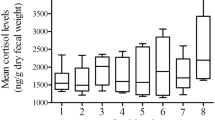Abstract
Using weight and skinfold thickness to calculate relative body fat, the fat content of 21 captive female rhesus macaques was estimated. Although age and. pregnancy had no effect on fat, rank was significant, especially during winter, with high-rank females having the highest fat scores. Rank therefore has a significant effect on the health of captive animals and may also affect the health of individuals in feral groups.
Similar content being viewed by others
References
Brozek, J. (1963). Quantitative description of body composition: Physical anthropology’s “fourth” dimension.Current Anthropol. 4: 3–39.
Damon, A., and Goldman, R. F. (1964). Predicting fat from body measurements: Densiometric validation of ten anthropometric equations.Human Biol. 36: 32–44.
Durnin, J. V. G. A., and Rahaman, M. M. (1967). The assessment of the amount of fat in the human body from measurements of skinfold thickness.Br. J. Nutr. 21: 681–689.
Edwards, D. A. W. (1950). Observations on the distribution of subcutaneous fat.Clin. Sci. Mol. Med. 9: 259–270.
Edwards, D. A. W., Hammond, W. H., Healy, M. J. R., Tanner, T. M., and Whitehouse, R. H. (1955). Design and accuracy of calipers for measuring subcutaneous tissue thickness.Br. J. Nutr. 9: 122–143.
Frisch, R. E., and McArthur, J. W. (1974). Menstrual cycles; fatness as a determinant of minimum weight for height necessary for their maintenance or onset.Science 185: 949–951.
Keys, A., and Brozek, J. (1953). Body fat in adult man.Physiol. Rev. 33: 245–325.
Lehner, P. N. (1979).Handbook of Ethological Methods, Garland Press, New York.
Parnell, R. W. (1958).Behaviour and Physique, Edward Arnold, London.
Simpson, G. A., Roe, A., and Lewontin, R. C. (1960).Quantitative Zoology, Harcourt, Brace and World, New York.
Small, M. F. (1980).Females Without Infants: A Comparison of Captive Rhesus Macaques (Macaca mulatta)and Bonnet Macaques (Macaca radiata), Unpublished Ph.D. dissertation, University of California, Davis.
Wilmore, J. H., and Behnke, A. R. (1970). An anthropometric estimation of body density and lean body weight in young women.Am. J. Clin. Nutr. 23: 267–274.
Author information
Authors and Affiliations
Rights and permissions
About this article
Cite this article
Small, M.F. Body fat, rank, and nutritional status in a captive group of Rhesus Macaques. Int J Primatol 2, 91–95 (1981). https://doi.org/10.1007/BF02692303
Received:
Issue Date:
DOI: https://doi.org/10.1007/BF02692303




